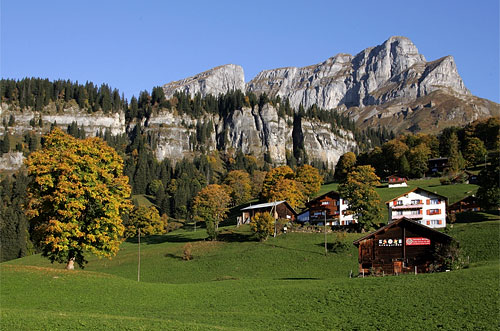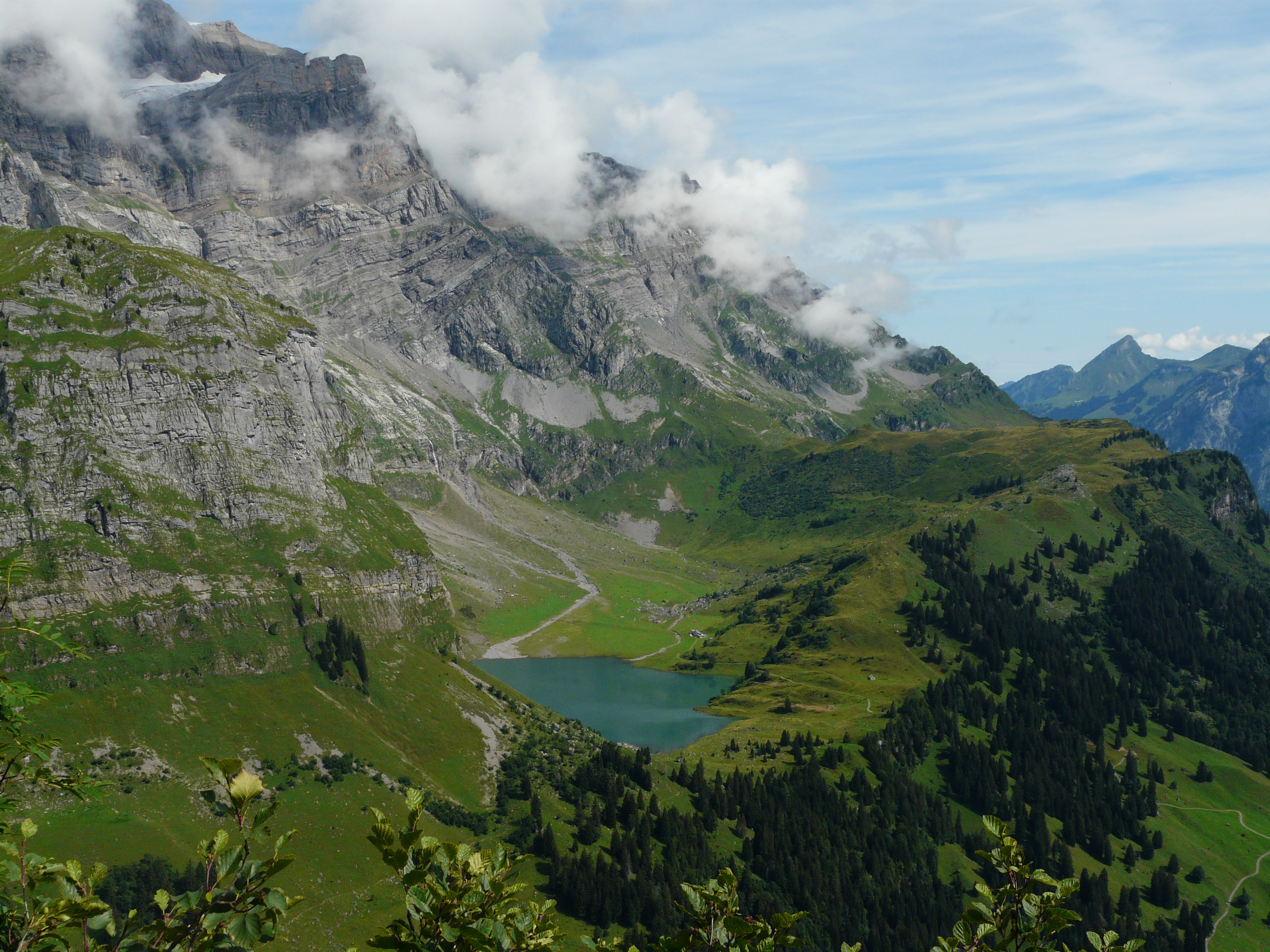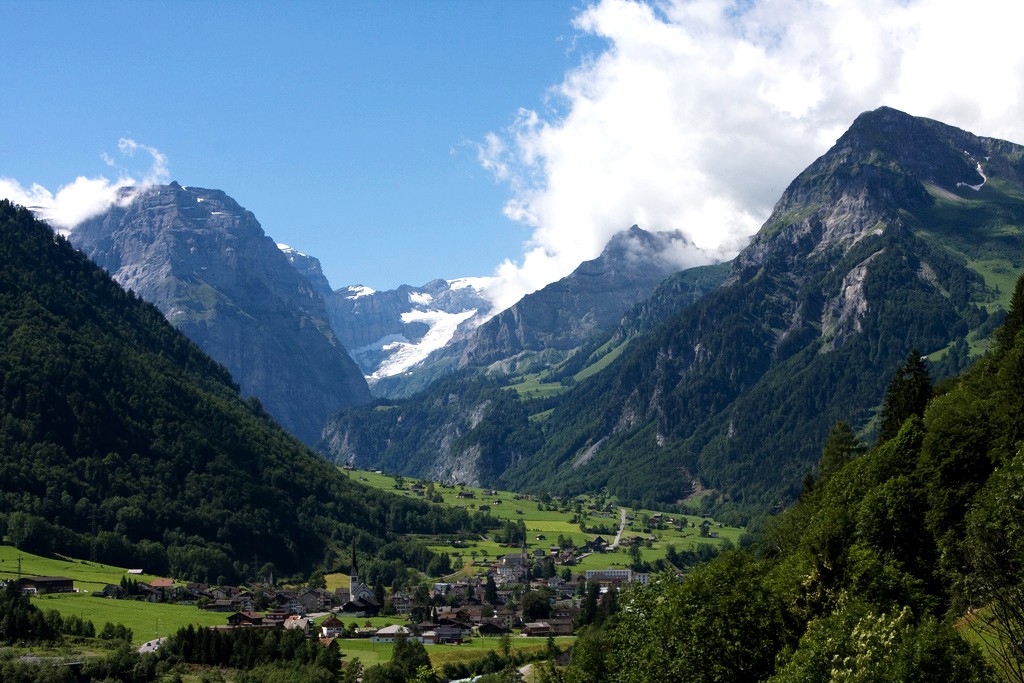|
Hätzingen
Hätzingen is a village, and former municipality, in the municipality of Glarus Süd and canton of Glarus in Switzerland. History Hätzingen is first recorded in 1350 as ''Hezzinge(n)''. In 2004, the municipality of Hätzingen was merged into the municipality of Luchsingen. On 1 January 2011, the municipality of Luchsingen was itself merged into the new municipality of Glarus Süd. Geography Hätzingen is located in the valley of the Linth river, with the village situated on the east bank of the river, at an elevation of approximately . The village of Diesbach lies to the south. To the north, the next village is Luchsingen, which lies on the west bank of the river, and Haslen, on the east bank. Transport Hätzingen is located on the Hauptstrasse 17, which runs the length of the canton of Glarus before climbing the Klausen Pass into the canton of Uri, as well as on the Weesen to Linthal railway line that parallels the main road and the Linth river through Glarus. The h ... [...More Info...] [...Related Items...] OR: [Wikipedia] [Google] [Baidu] |
Glarus Süd
Glarus Süd is a municipality in the Swiss canton of Glarus. It comprises the upper Linth valley, and the entire Sernf valley, and includes the villages of Betschwanden, Braunwald, Diesbach, Elm, Engi, Haslen, Hätzingen, Leuggelbach, Linthal, Luchsingen, Matt, Mitlödi, Nidfurn, Rüti, Schwanden, Schwändi and Sool. Glarus Süd is one of three municipalities of the canton of Glarus, the others being Glarus and Glarus Nord. History The municipality of Glarus Süd was created on 1 January 2011, incorporating the former municipalities of Betschwanden, Braunwald, Elm, Engi, Haslen, Linthal, Luchsingen, Matt, Mitlödi, Rüti, Schwanden, Schwändi and Sool. At the time of its creation, Glarus Süd was the largest Swiss municipality by area. As of 1 January 2015, it was overtaken in size by the expanded municipality of Scuol in the canton of Graubünden. Geography Glarus Süd incorporates all of the valley of the Linth river from Mitlödi, just upstream of the tow ... [...More Info...] [...Related Items...] OR: [Wikipedia] [Google] [Baidu] |
Luchsingen-Hätzingen Railway Station
Luchsingen-Hätzingen railway station is a railway station in the municipality of Glarus Süd in the Swiss canton of Glarus. It takes its name from the nearby villages of Luchsingen and Hätzingen. The station is situated on the Weesen to Linthal railway line, and served by the hourly Zürich S-Bahn The Zürich S-Bahn (german: S-Bahn Zürich) system is a network of rail lines that has been incrementally expanded to cover the ZVV area, which comprises the entire canton of Zürich and portions of neighbouring cantons (Aargau, Glarus, ... service S25 between Zurich and Linthal. References Railway stations in the canton of Glarus Swiss Federal Railways stations {{Switzerland-railstation-stub ... [...More Info...] [...Related Items...] OR: [Wikipedia] [Google] [Baidu] |
Luchsingen
Luchsingen is a village, and former municipality, in the municipality of Glarus Süd and canton of Glarus in Switzerland. History Luchsingen is first mentioned in 1274 as ''Luchsingen''. In 2004 the former municipalities of Hätzingen and Diesbach were merged into the municipality of Luchsingen. On 1 January 2011, the enlarged municipality became part of the municipality of Glarus Süd. Geography Luchsingen is located in the valley of the Linth river, with the village located on the west bank of the river at an elevation of approximately . Leuggelbach lies to the north, whilst Hätzingen lies across the river to the south. Besides the village of Luchsingen, the area includes the hamlet of Adlenbach and the vacation home development of Schlatt. Above the village to the west is the valley of the Bächibach stream and the Oberblegisee lake (at an elevation of ), which are below the mountains of Eggstock (), Bös Fulen (), Rüchigrat () and Glärnisch (). Luchsingen has an are ... [...More Info...] [...Related Items...] OR: [Wikipedia] [Google] [Baidu] |
S25 (ZVV)
The S25 is a regional railway line of the S-Bahn Zürich on the Zürcher Verkehrsverbund (ZVV), Zürich transportation network, and is one of the network's lines connecting the cantons of Zürich with Schwyz, Glarus and St. Gallen. The line was introduced in July 2014, and replaces the less frequent Glarner Sprinter train. History Between 1918 and 2004, there was no direct connection from the canton of Glarus to the city of Zürich. In 2004, the through Glarner Sprinter train was introduced, but financial and technical limitations meant this train only ran every two hours on weekdays, and twice a day on weekends and holidays. It also only reached Linthal, the terminus of the line in Glarus, on weekends and holidays. In July 2014, these limitations were finally overcome, and the Glarner Sprinter was replaced by the hourly S25 service to Linthal. Route * The line links Zürich Hauptbahnhof with the canton of Glarus, terminating at the village of Linthal and the head of ... [...More Info...] [...Related Items...] OR: [Wikipedia] [Google] [Baidu] |
Canton Of Glarus
The canton of Glarus (german: Kanton Glarus rm, Chantun Glaruna; french: Canton de Glaris; it, Canton Glarona) is a canton in east central Switzerland. The capital is Glarus. The population speaks a variety of Alemannic German. The majority of the population (81%) identifies as Christian, about evenly split between Protestants and Catholics. History According to legend, the inhabitants of the Linth Valley were converted to Christianity in the 6th century by the Irish monk Saint Fridolin, the founder of Säckingen Abbey in what is now the German state of Baden-Württemberg. From the 9th century, the area around Glarus was owned by Säckingen Abbey, the town of Glarus being recorded as ''Clarona''. The Alemanni began to settle in the valley from the early 8th century. The Alemannic German language took hold only gradually, and was dominant by the 11th century. By 1288, the Habsburgs had claimed all the abbey's rights. Glarus joined the Old Swiss Confederacy in 1352 as one of t ... [...More Info...] [...Related Items...] OR: [Wikipedia] [Google] [Baidu] |
Haslen, Glarus
Haslen is a village, and former municipality, in the municipality of Glarus Süd and canton of Glarus in Switzerland. History Haslen is first mentioned in 1289 as ''Burchard von Hasle''. On 1 July 2006, the municipality of Haslen incorporated the neighbouring municipalities of Leuggelbach and Nidfurn. On 1 January 2011, Haslen was itself merged into the new municipality of Glarus Süd. Geography Haslen is in the valley of the Linth river, and the village is on the east bank of the river at an elevation of approximately . The villages of Leuggelbach and Diesbach lie across the river to the west, whilst Hätzingen is to the south and Schwanden is to the north. Haslen consists of the linear village of Haslen itself, the hamlets of Leu (formerly Nesslau), Oberhaslen, Büel, Zussigen and Mülibächli. Haslen has an area, as defined by the former municipal boundaries in 2006, of . Of this area, 42.9% is used for agricultural purposes, while 45.2% is forested. Of the rest of th ... [...More Info...] [...Related Items...] OR: [Wikipedia] [Google] [Baidu] |
Diesbach, Glarus
Diesbach is a village, and former municipality, in the municipality of Glarus Süd and canton of Glarus in Switzerland. History Diesbach is first recorded in 1350 as ''Diesbach''. In 2004, the municipality of Diesbach was merged into the municipality of Luchsingen. On 1 January 2011, the municipality of Luchsingen was itself merged into the new municipality of Glarus Süd. Geography Diesbach is located in the valley of the Linth river, with the village situated on the east bank of the river, at an elevation of approximately . The village of Betschwanden lies to the south and Hätzingen to the north. Above the village to the south-east is the mountain of Kärpf (). Transport Diesbach is located on the Hauptstrasse 17, which runs the length of the canton of Glarus before climbing the Klausen Pass into the canton of Uri, as well as on the Weesen to Linthal railway line that parallels the main road and the Linth river through Glarus. The high alpine Klausen Pass is normally ... [...More Info...] [...Related Items...] OR: [Wikipedia] [Google] [Baidu] |
Thomas Thomassen Heftye
Thomas Thomassen Heftye (10 April 1860 – 19 September 1921) was a Norwegian military officer, engineer, sports official and politician for the Liberal Party. He is best known as the Norwegian Minister of Defence from June to October 1903 and March to April 1908, as well as the director of Telegrafverket. He was killed in the Nidareid train disaster. Personal life He was born in Vestre Aker as the son of banker Thomas Johannessen Heftye (1822–1886) and his wife Marie Jacobine Meyer (1826–1895). He was a grandson of banker and politician Johannes Thomassen Heftye. His great-grandfather migrated to Norway from Hätzingen, Switzerland in the late eighteenth century, and founded the family company Thos. Joh. Heftye & Søn. He was also a grandnephew of Henrik Thomassen Heftye. In May 1888 he married Marie Berghaus (1869–1931). Career Heftye finished his secondary education in 1878, and took a military education in the following years. From 1880 he worked in the family com ... [...More Info...] [...Related Items...] OR: [Wikipedia] [Google] [Baidu] |
Linth River
The Linth (pronounced "lint") is a Swiss river that rises near the village of Linthal in the mountains of the canton of Glarus, and eventually flows into the Obersee section of Lake Zurich. It is about in length. The water power of the Linth was a main factor in the creation of the textile industry of the canton Glarus, and is today used to drive the Linth–Limmern power stations in its upper reaches. The river and its upper valley forms the boundary between the mountain ranges of the Glarus Alps, to its east and south, and the Schwyzer Alps, to its west. Course of the river The river rises to the south-west of the village of Linthal, at the foot the Tödi mountain (elevation ). It collects the water from several glaciers, including the Clariden Glacier and the Biferten Glacier, as well as various tributary streams, including the ''Oberstafelbach'', the ''Bifertenbach'', the ''Sandbach'', the ''Walenbach'' and the ''Limmerenbach''. The last of these is dammed to create t ... [...More Info...] [...Related Items...] OR: [Wikipedia] [Google] [Baidu] |
Canton Of Glarus
The canton of Glarus (german: Kanton Glarus rm, Chantun Glaruna; french: Canton de Glaris; it, Canton Glarona) is a canton in east central Switzerland. The capital is Glarus. The population speaks a variety of Alemannic German. The majority of the population (81%) identifies as Christian, about evenly split between Protestants and Catholics. History According to legend, the inhabitants of the Linth Valley were converted to Christianity in the 6th century by the Irish monk Saint Fridolin, the founder of Säckingen Abbey in what is now the German state of Baden-Württemberg. From the 9th century, the area around Glarus was owned by Säckingen Abbey, the town of Glarus being recorded as ''Clarona''. The Alemanni began to settle in the valley from the early 8th century. The Alemannic German language took hold only gradually, and was dominant by the 11th century. By 1288, the Habsburgs had claimed all the abbey's rights. Glarus joined the Old Swiss Confederacy in 1352 as one of t ... [...More Info...] [...Related Items...] OR: [Wikipedia] [Google] [Baidu] |
Thomas Johannessen Heftye
Thomas Johannessen Heftye, also known as Tho Joh Heftye (29 October 1822 – 4 October 1886) was a Norwegian businessman, politician and philanthropist. Personal life He was born in Christiania as the son of merchant Johannes Thomassen Heftye (1792–1856) Tina Haslef (1798–1862). He was a nephew of Henrik Heftye. In October 1846 he married Marie Jacobine Meyer (1826–1895), a daughter of Jacob Peter Meyer and sister of Thorvald Meyer. Their son Thomas Heftye became a notable politician. Through his daughter Ingeborg Marie he was a father-in-law of Frits Hansen and grandfather of Eilif Fougner. Career His grandfather migrated to Norway from Switzerland in the late eighteenth century, and founded the family company Thos. Joh. Heftye & Søn. Heftye grew up at Filipstad. He took his secondary education at Oslo Cathedral School and his higher education mainly in Leipzig. He entered the family company in 1848. Heftye was heavily involved in the organizational life of the ti ... [...More Info...] [...Related Items...] OR: [Wikipedia] [Google] [Baidu] |







